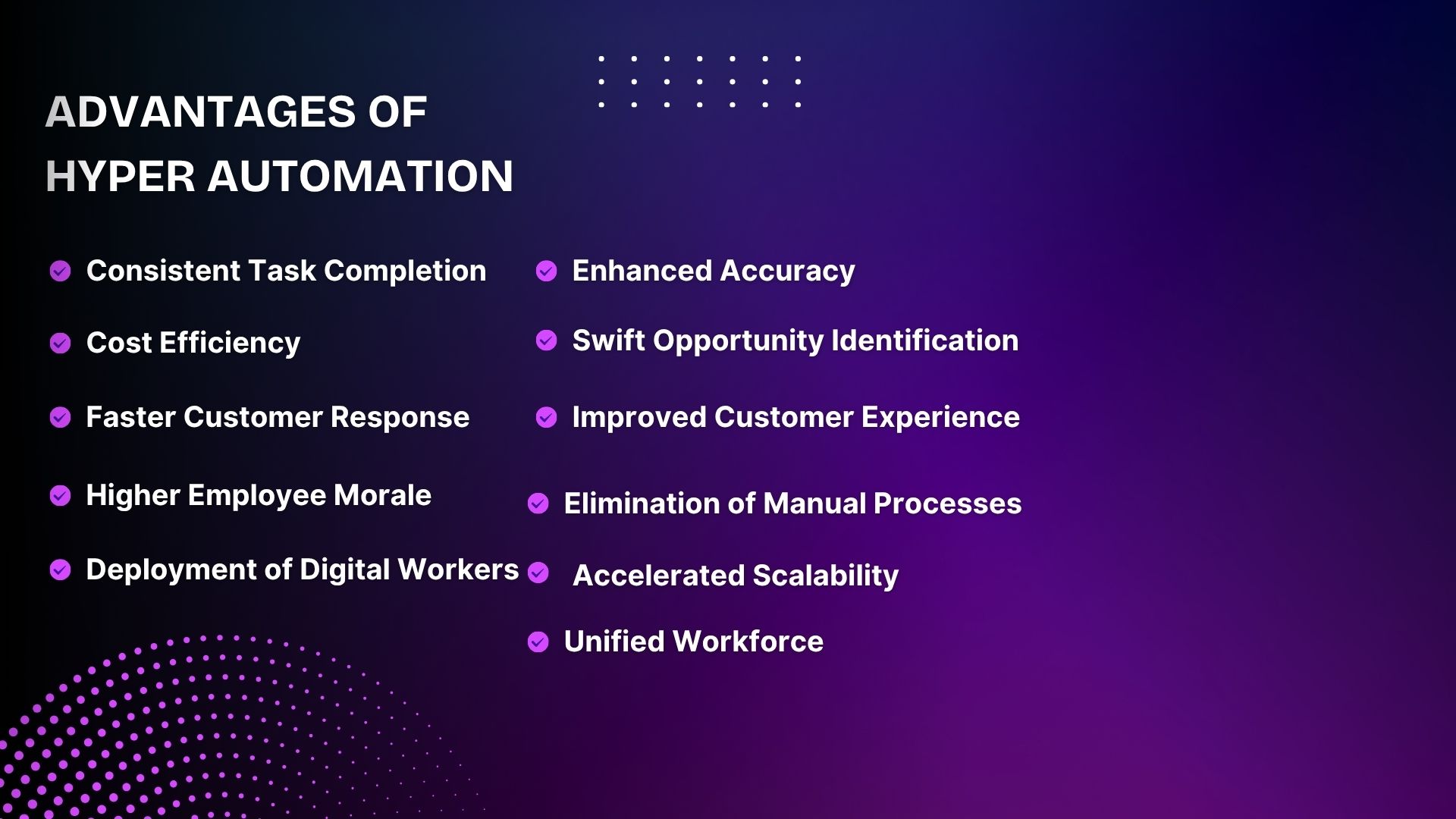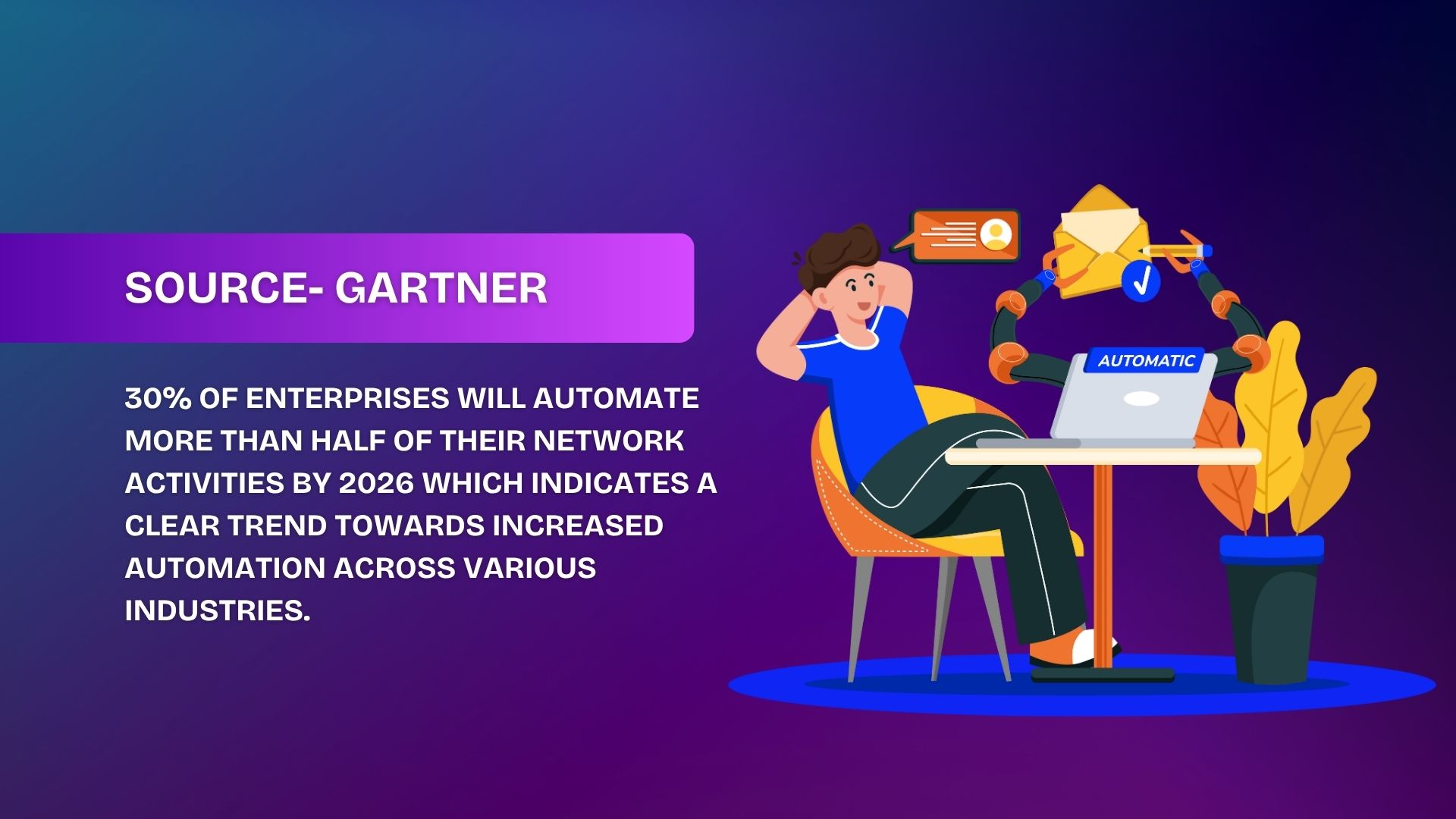
Hyper Automation is The Next Phase of Intelligent Business Operations
Optimizing business processes has become important for effective operations. While basic process automation helps teams focus on high-value tasks, its scope is often limited.
Hyper Automation is the next evolution in achieving operational excellence.
This integrates Artificial Intelligence (AI), Machine Learning (ML), and Robotic Process Automation (RPA). Hyper Automation creates an intelligent ecosystem that automates complex, interconnected workflows by combining these technologies. Its effectiveness is further boosted by incorporating process mining and analytics platforms, giving businesses full visibility into their operations and enabling continuous analysis and optimization.
Hyper automation is already transforming various sectors. Healthcare organizations, for example, are using it to revolutionize patient care through automated scheduling and billing, leading to improved patient outcomes. Manufacturers are deploying AI-powered systems to proactively prevent equipment failures, resulting in substantial operational benefits.
This aims to boost operational efficiency, minimize manual effort, enhance accuracy, and promote business growth by building a flexible and robust automation framework.
Hyper Automation vs. Automation
While both hyper automation and intelligent automation help in streamlining operations, their scope and speed differ significantly.
Intelligent automation (IA) combines technologies like Robotic Process Automation (RPA), artificial intelligence (AI), and machine learning (ML). Essentially, IA links the “thinking” capabilities of AI (for decision-making and scaling) with the “doing” capabilities of RPA, which handles repetitive tasks. It’s about using these tools to automate processes more intelligently than traditional, rule-based automation. You might also hear IA referred to as cognitive automation.
Hyper Automation, on the other hand, is an accelerated and expanded approach to automation. It goes beyond individual process improvements to rapidly identify and automate as many business and IT processes as possible across an organization. It uses a broad range of automation technologies, often including IA, to quickly transform operations and replace manual tasks on a large scale. Think of it as a comprehensive and rapid push towards end-to-end automation.
The Power of Hyper Automation in Streamlining Business Processes
Hyper Automation is a transformative approach to business optimization, focusing on automating every possible process within an organization. It goes beyond traditional automation by building on past insights and integrating cutting-edge technologies to truly reinvent how work gets done. Essentially, hyper automation automates the very act of automation itself, leading to significant reductions in manual effort and dramatic improvements in efficiency.
This comprehensive strategy aims to create streamlined workflows that operate with minimal human intervention. Like intelligent automation, hyper automation utilizes digital workers to handle repetitive tasks, freeing up human employees to concentrate on more complex, higher-value activities. This shift not only boosts overall productivity but also enhances the employee experience by eliminating mundane work.
While Robotic Process Automation (RPA) is a core component, deploying software bots to execute tasks, hyper automation also uses a suite of complementary technologies like-
- Optical Character Recognition (OCR)
- Low-code/no-code platforms
- Intelligent Document Processing (IDP)
- Natural Language Processing (NLP)
- Artificial Intelligence (AI)
- Machine Learning (ML)
- Business Process Management (BPM)
- Agentic AI
The Operating Mechanism of Hyper automation
Making hyper automation work effectively relies on a variety of powerful tools, with process intelligence and business process management being two of the most significant.
1. Process Intelligence
Process intelligence offers clear insights into your business processes without requiring the extensive manual effort typically associated with analysts or Centers of Excellence (CoE). This approach uncovers bottlenecks and identifies opportunities for optimization and scaling your automations by combining process mining, task mining, and business intelligence. Process intelligence is essential for pinpointing the right processes to automate and ensuring they operate at their best.
2. Business Process Management
Business Process Management (BPM) is a comprehensive approach to managing automation that encompasses analyzing, monitoring, and optimizing end-to-end business processes. BPM functions as both a discipline and a technology. As a discipline, it helps measure the success of individual processes and provides oversight for the entire automation journey. As an intelligent automation technology, BPM connects processes, people, technology, digital workers, data, and software to enable accurate and highly efficient work.
Practical Applications of Hyper Automation
Virtually every sector encounters process bottlenecks, from individual tasks that slow down work to organizational silos that impede entire workflows. Most organizations are actively seeking ways to improve efficiency across the board and reduce operating costs. Hyper Automation can be integrated into these processes to streamline workflows and boost employee productivity by enabling staff to focus on more engaging work.
Supply Chain
Manufacturing companies often grapple with supply chain challenges, where shortages can damage reputation and impact profitability. However, these challenges also present significant opportunities for hyper automation. Hyper automation can help eliminate human error and reduce time spent on manual checks of inventory statuses and shipping delays by automating key processes.
Automated processes within the supply chain include
- Inventory checks
- Product availability
- Procurement
- Pricing and billing
- Quote requests
- Customer follow-up
- Data input
- System maintenance and repair
- Healthcare
The healthcare industry heavily relies on streamlined and efficient processes to ensure superior patient experiences and prevent missed payments.
Examples of automation processes that can be implemented in healthcare are
- Billing cycles
- Payment collection
- Customer communication
- Appointment booking
- Record management
- Collecting and extracting data from various sources
- Improving patient care
- Keeping patient information up to date
- Managing drug inventory
- Scheduling staff
- Banking and Finance
The financial sector has numerous processes ripe for optimization through hyper automation. These processes demand accuracy and strict adherence to industry regulations, all of which can be managed effectively with a robust office automation strategy.
Common hyper automation use cases in financial services and banking are the following
- Data management
- Auto form filling
- Customer identification
- Loans processing and faster decision-making for loan requests
- Incident management
- Know Your Customer (KYC) compliance
- Anti-Money Laundering (AML) checks
- New customer onboarding
- Employee payroll
Advantages of Hyper Automation
Hyper Automation offers a rapid approach to implementing automation solutions without compromising the quality of the underlying processes. With a well-defined strategy and model for your automation journey, achieving your desired return on investment (ROI) becomes readily attainable.

- Consistent Task Completion– Makes sure that tasks are performed uniformly every time.
- Enhanced Accuracy– Minimizes errors, leading to improved precision.
- Cost Efficiency– Drives significant savings through optimized operations.
- Swift Opportunity Identification– Quickly pinpoints new areas for automation.
- Faster Customer Response– Enables quicker reactions to customer needs.
- Improved Customer Experience– Leads to greater satisfaction for your clients.
- Higher Employee Morale– Frees human workers from mundane tasks, boosting job satisfaction.
- Elimination of Manual Processes– Automates repetitive, labor-intensive activities.
- Deployment of Digital Workers– Utilizes software bots to handle routine tasks.
- Accelerated Scalability– Facilitates rapid expansion of automated processes across the organization.
- Unified Workforce– Seamlessly integrates digital and human employees.
Overcoming Hyper Automation Challenges
- Measuring Success– Difficulty in accurately assessing the effectiveness of hyper automation technologies.
- Realistic Timelines– Developing achievable schedules for implementation.
- Assigning Ownership– Determining appropriate leadership and accountability for automated processes.
- Accurate ROI Calculation– Challenges in precisely quantifying the financial returns.
- Software Selection– Choosing the most suitable automation software.
- AI Integration– Deciding where to effectively incorporate artificial intelligence.
- Stakeholder Buy-in– Securing approval and support from management and key stakeholders.
Luckily, you don’t have to walk this path alone. Partners like PCPL specialize in providing the tools to make informed decisions. They can support your organization in identifying which technologies to adopt, enabling greater agility through automation and helping you achieve your intended business outcomes.
Is Hyper Automation Right for Your Business?
Large enterprises and sectors rich in data are particularly well-suited for hyper automation. This is due to their operational nature- they often deal with high volumes of repetitive tasks that demand efficient scaling.
Beyond efficiency, hyper automation also empowers organizations to meet rigorous compliance and regulatory demands. It achieves this by minimizing human error and automating critical processes like documentation, audit trails, and data security, thereby significantly lowering risks.
Consider these practical applications- finance companies can streamline loan approvals or fraud detection, retail can optimize inventory management, and healthcare can enhance imaging and diagnostics. Businesses aiming for growth can use hyper automation to scale operations without proportionally increasing employee workload or headcount.

Ways to Deploy Hyper Automation
For a hyper automation strategy to truly succeed, organizations must first gauge their readiness to weave various technologies into their current operations. This journey starts with a thorough process analysis, smart resource allocation, and setting up clear Key Performance Indicators (KPIs) for continuous evaluation.
This methodical approach empowers leaders to strike a balance: focusing on areas with the greatest potential for impact while also providing much-needed automation support to departments that need it most.
The actual deployment should then unfold in a step-by-step manner. Businesses can begin integrating hyper automation in ways that directly address their unique operational needs. Further, it’s important to continuously review and refine your hyper automation strategy. This ongoing adjustment ensures the solutions function as intended and helps head off future complications.
Securing Your Business Future with Hyper Automation
Process automation has gone far beyond simply streamlining individual tasks. It’s now a comprehensive, large-scale strategy, known as hyper automation, designed to optimize entire workflows.
This approach is particularly valuable for businesses aiming to scale efficiently without a proportional increase in operational costs, which is crucial for organizations focused on smart growth.
In sectors like technology, healthcare, and finance, where speed to market is paramount, hyper automation can significantly shorten development cycles and alleviate bottlenecks. This empowers businesses to launch new offerings with greater agility.
Organizations that successfully implement hyper automation can achieve sustainable operational efficiency, maintain their competitive edge, improve both employee and customer experiences, and drive innovation.
As hyper automation continues to evolve, it will play an increasingly central role in enterprise operations, making it an indispensable strategy for forward-thinking businesses.
References
https://www.blueprism.com/guides/hyperautomation/
https://www.ricoh-ap.com/insights/2024/12/11/hyperautomation-the-future-of-process-automation
